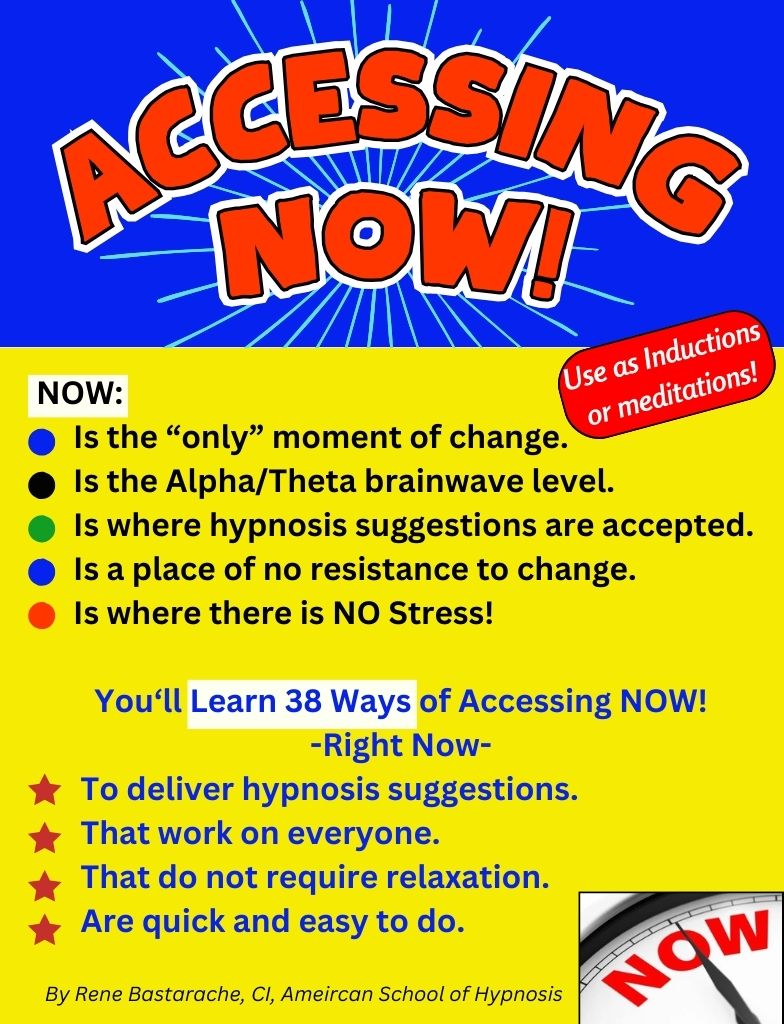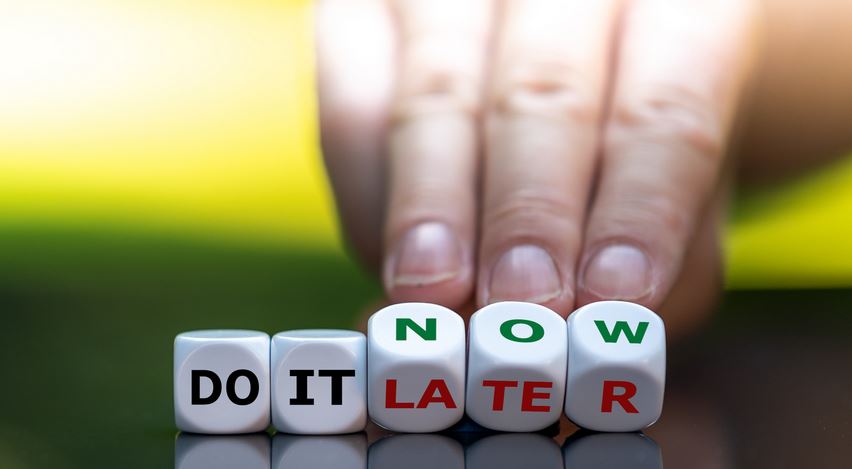 .ACCESSING NOW
.ACCESSING NOW
GUIDED HYPNOSIS INDUCTIONS
& MEDITATIONS
Royalty Free!
The best hypnotic level where you are more open to suggestion than any other point is in the Alpha/Theta level; also known as the Now or Present Moment. The Hypnotist usually relaxes their client until they reach this level, before delivering suggestions during a session.
In fact, “all” change is made in the now moment. The past is gone and the future hasn’t arrived. We only have now!
Here are the instructions for 38 different ways to get your client to this now method where there’s no conscious resistance. Most of them don’t even require relaxation.
 It is a wonderful place to access, to deliver powerful hypnotic suggestions, self-affirmations or even to conduct meditation. Read the descriptions below and find the ones that work best for you and your clients. The key ingredient in all of them is “Focus”. You can focus on your breathing, an object, a texture, sound or one of 30 other focal points shown below.
It is a wonderful place to access, to deliver powerful hypnotic suggestions, self-affirmations or even to conduct meditation. Read the descriptions below and find the ones that work best for you and your clients. The key ingredient in all of them is “Focus”. You can focus on your breathing, an object, a texture, sound or one of 30 other focal points shown below.
If there were EVER a time to take advantage of a new manual to expand your horizons and help more people, this is it. Study the rest of this page and get yours Now!
.
TECHNIQUES INCLUDED:
1. Mindfulness Meditation:
Encourage individuals to focus on their breath, sensations, or an object without necessarily guiding them through a progressive relaxation. This approach helps in cultivating awareness and being present in the moment.
2. Body Scan Technique:
Instead of a full-body relaxation, guide individuals to bring their attention to specific parts of their body, starting from the toes and moving upward. This method encourages awareness without inducing a typical relaxation response.
3. Observation of Surroundings:
Prompt individuals to become fully aware of their immediate environment. Ask them to notice details such as colors, shapes, sounds, and textures. This helps in grounding them in the present moment.
4. Active Listening Exercise:
Engage participants in an exercise where they actively listen to a piece of music, the sounds around them, or your voice. Encourage them to notice subtle nuances and details they might not typically pay attention to.
5. Visualization of a Calm Place:
Guide individuals to imagine and vividly visualize a serene and peaceful place. This could be a beach, forest, or any location that invokes a sense of tranquility. The focus is on the details of this mental image.
6. Sensory Awareness:
Have participants engage their senses by focusing on one sense at a time. For example, ask them to close their eyes and listen intently to the sounds around them, then shift to focusing solely on touch, smell, or taste.
7. Mindful Movement:
Incorporate gentle movements like tai chi, yoga, or simple stretching exercises. The emphasis is on the awareness of each movement and the sensations associated with it.
 8. Breath Awareness Variation:
8. Breath Awareness Variation:
Rather than counting breaths, have individuals focus on the sensation of the breath itself – feeling the coolness as they inhale and the warmth as they exhale.
9. Time Distortion Exercise:
Guide individuals to play with their perception of time. This can involve asking them to slow down or speed up their mental clock, helping them detach from the usual sense of time-related stress.
10. Color Meditation:
Ask individuals to focus on a specific color in their mind’s eye. They can visualize the color filling their entire awareness, helping them become more present and centered.
11. Gratitude Practice:
Guide individuals to think about and express gratitude for the positive aspects of their lives. This practice shifts focus to the present moment and fosters a sense of appreciation.
12. Breath Pacing:
Instead of simple breath counting, instruct participants to match their breath to a specific rhythm. This rhythmic breathing can bring about a sense of balance and presence.
13. Object Exploration:
Provide participants with a small, interesting object. Ask them to explore the object as if they’ve never seen it before, noticing details, textures, and any emotions or thoughts that arise.
14. Progressive Sensation Awareness:
Instead of relaxing the entire body progressively, guide individuals to become aware of various sensations throughout their body, such as warmth, tingling, or pulsations.
15. Five Senses Exercise:
Engage all five senses by asking participants to identify five things they can see, four things they can touch, three things they can hear, two things they can smell, and one thing they can taste.
16. Rapid Word Association:
Have individuals close their eyes and say or think of words rapidly for about a minute. This helps disrupt the normal stream of consciousness and can lead to increased present-moment awareness.
 17. Name and Describe:
17. Name and Describe:
Prompt participants to name and describe, in detail, several objects or elements in their immediate surroundings. This exercise encourages mindfulness and focus on the present environment.
18. Visual Patterns:
Provide individuals with a visually complex pattern or image. Ask them to explore the details of the pattern, moving their attention slowly across the entire image.
19. Thought Observation:
Instruct individuals to observe their thoughts without judgment. This mindfulness approach involves acknowledging thoughts as they arise and allowing them to pass without attachment.
20. Body Tapping or Touch Awareness:
Instruct the person to gently tap different parts of their body or become aware of the sensation of touch.
This technique brings attention to the physical body and can be done subtly in any environment.
21. Symbolic Gesture:
Have the person choose a simple, symbolic gesture. Instruct them to use this gesture whenever they feel distracted or overwhelmed to bring their focus back to the present moment.
22. Grounding Objects:
Provide a small, portable object and ask the person to carry it with them. In moments of stress or distraction, they can hold or touch the object, using it as a tactile anchor to bring them back to the present.
23. Imaginary Time Capsule:
Ask the person to imagine placing their current worries, thoughts, or distractions into an imaginary time capsule.
Instruct them to mentally seal the capsule and set it aside, allowing them to focus on the present without the weight of future or past concerns.
24. Coloring or Drawing Mindfully:
Provide coloring materials and encourage the person to color or draw mindfully, paying attention to the colors, shapes, and movements. Engaging in creative activities can redirect attention to the present moment and provide a calming effect.
25. Guided Body Scan with Sound:
Combine a traditional body scan with sound awareness. Instruct the person to sequentially focus on different parts of their body while simultaneously listening to specific sounds in their environment
 26. Nature Connection:
26. Nature Connection:
Encourage the person to connect with nature by observing and appreciating natural elements such as trees, leaves, or the sky. This technique helps ground individuals in the present moment by fostering a connection with the external environment.
27. Unplugging Meditation:
Encourage the person to temporarily unplug from electronic devices. Have them sit comfortably and close their eyes, focusing on the absence of digital stimuli and connecting with the present moment.
28. Five-Finger Breathing:
Guide the person in a breathing exercise where they trace each finger on one hand with the index finger of the other hand, coordinating the movement with their breath. Inhale while tracing up, exhale while tracing down. This combines tactile awareness with mindful breathing.
29. Nature Connection:
Suggest a slow, mindful walk in a natural setting. Instruct them to pay attention to the sensation of each step, the sounds of nature, and the overall experience of walking in the present moment.
30. Expressive Movement:
Guide the person to engage in expressive movement, encouraging them to move their body freely without judgment.
This technique combines physical activity with mindfulness, promoting a direct experience of the body in the present moment.
31. Unplugging Meditation technique:
The Unplugging Meditation technique involves intentionally disconnecting from digital devices to cultivate mindfulness and a sense of presence. Here’s a script you might use when guiding someone through this exercise:
32. One-Minute Mindfulness:
Set a timer for one minute and ask the person to fully focus on their breath during that time.
It’s a short yet effective way to bring attention to the present and can be done discreetly in various situations.
33. Name That Scent:
Bring attention to the sense of smell. Have the person identify and describe different scents around them.
This sensory awareness exercise can be done with items like essential oils, herbs, or even everyday objects.
34. Alphabet Gratitude:
Prompt the person to think of something they are grateful for starting with each letter of the alphabet.
This exercise redirects the mind towards positive thoughts and anchors it in the present moment.
35. Laughing Meditation:
Encourage laughter, whether through recalling a funny memory or engaging in light-hearted activities.
Laughter is an immediate way to shift focus and connect with the joy of the present moment.
 36. Shadow Watching:
36. Shadow Watching:
On a sunny day, invite the person to observe and interact with their shadow. This activity encourages a playful and visual connection with the present moment.
37. Texture Exploration:
Provide a variety of textured materials and guide the person to explore and describe the textures mindfully.
This tactile exercise enhances sensory awareness.
38. Affirmation Pause:
Encourage the person to pause and silently repeat a positive affirmation or mantra.
This practice helps redirect thoughts and emotions, fostering a positive and present mindset.
.
ROYALTY FREE!
In  fact, you’ll be so impressed with the scripts in this manual that we’re making them ROYALTY FREE! Not only will you have scripts to use with your clients but you’ll also be able to create your own recorded sessions to sell on your online stores or webpages.
fact, you’ll be so impressed with the scripts in this manual that we’re making them ROYALTY FREE! Not only will you have scripts to use with your clients but you’ll also be able to create your own recorded sessions to sell on your online stores or webpages.
What does “Royalty Free” mean?
You can use these scripts as if they were your own for recording, selling your own recordings and even copying them in print. About the only thing you cannot do is resell the manual or printed scripts as they are copy-written.
If you’ve looked around, I’m sure you’ve seen that it’s hard to find a Royalty Free Hypnosis Script anywhere online for under $15 each, if you can even find them at all. So now you can see why this is such a spectacular offer.
.
READY TO EXPAND YOUR HORIZONS?
 .
.
Only $74.00

DELIVERY FORMAT: This is an instant computer downloadable (pdf) script manual. If you have any questions about your delivery or you did not receive it immediately please contact us at admin@choosehypnosis.com. Thank you.
Legal Disclaimer Notice: The materials in this manual are the author’s opinions and understanding of hypnosis. Always be sure to work within your realm of practice. Neither the author nor the American School of Hypnosis are responsible in any way, shape or form for any loss or liability caused by utilization of any of the information presented in this publication. We are not medical or mental health practitioners and these scripts were created as a helpmate to your practice. Please seek out the advice and permission of a physician before using any of our scripts of a medical, health or healing nature to ensure they are safe and acceptable to the user.
